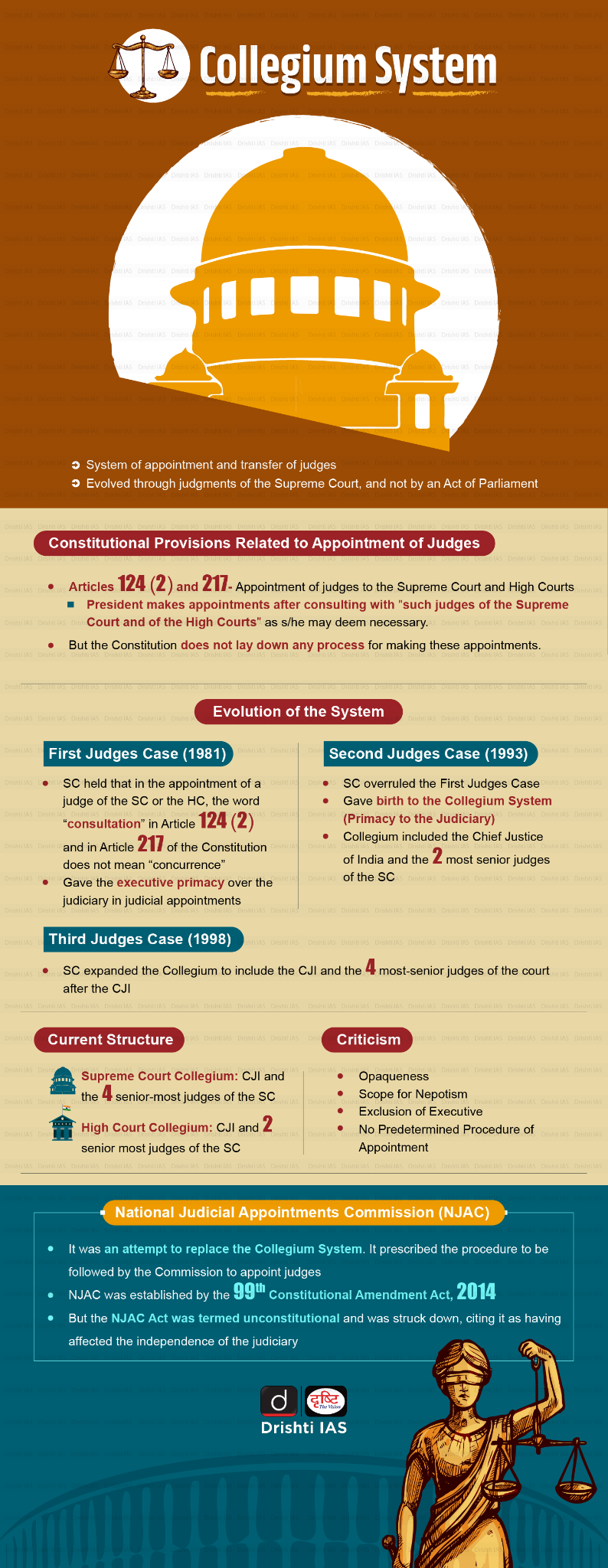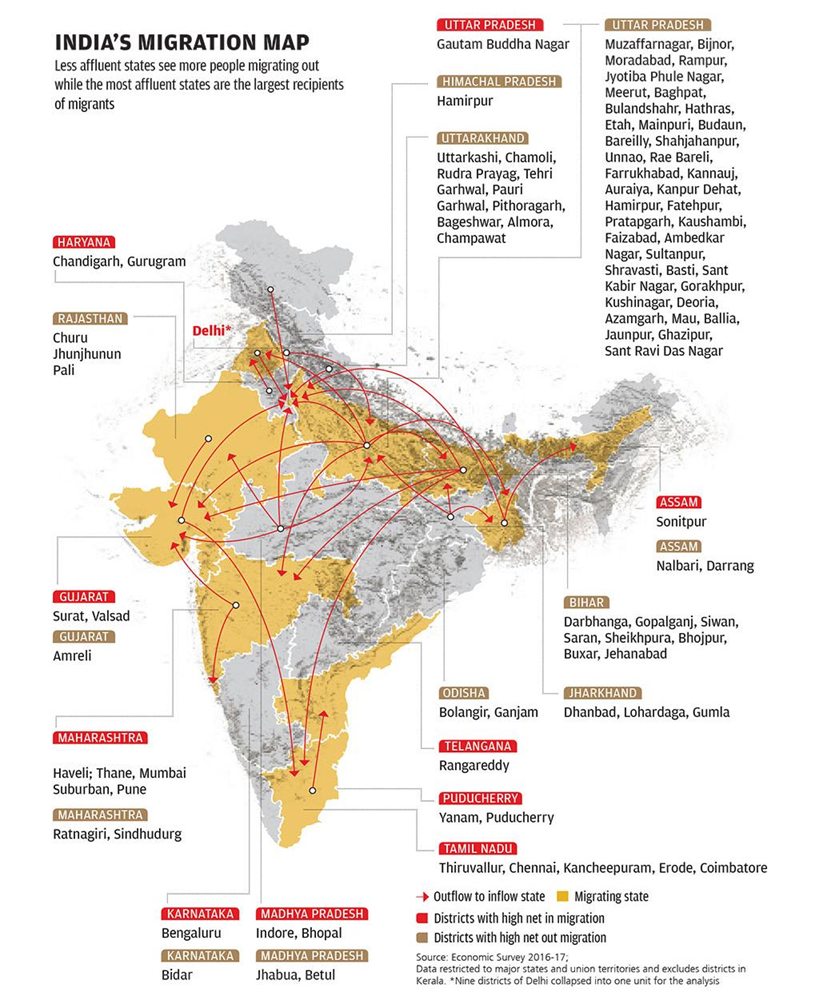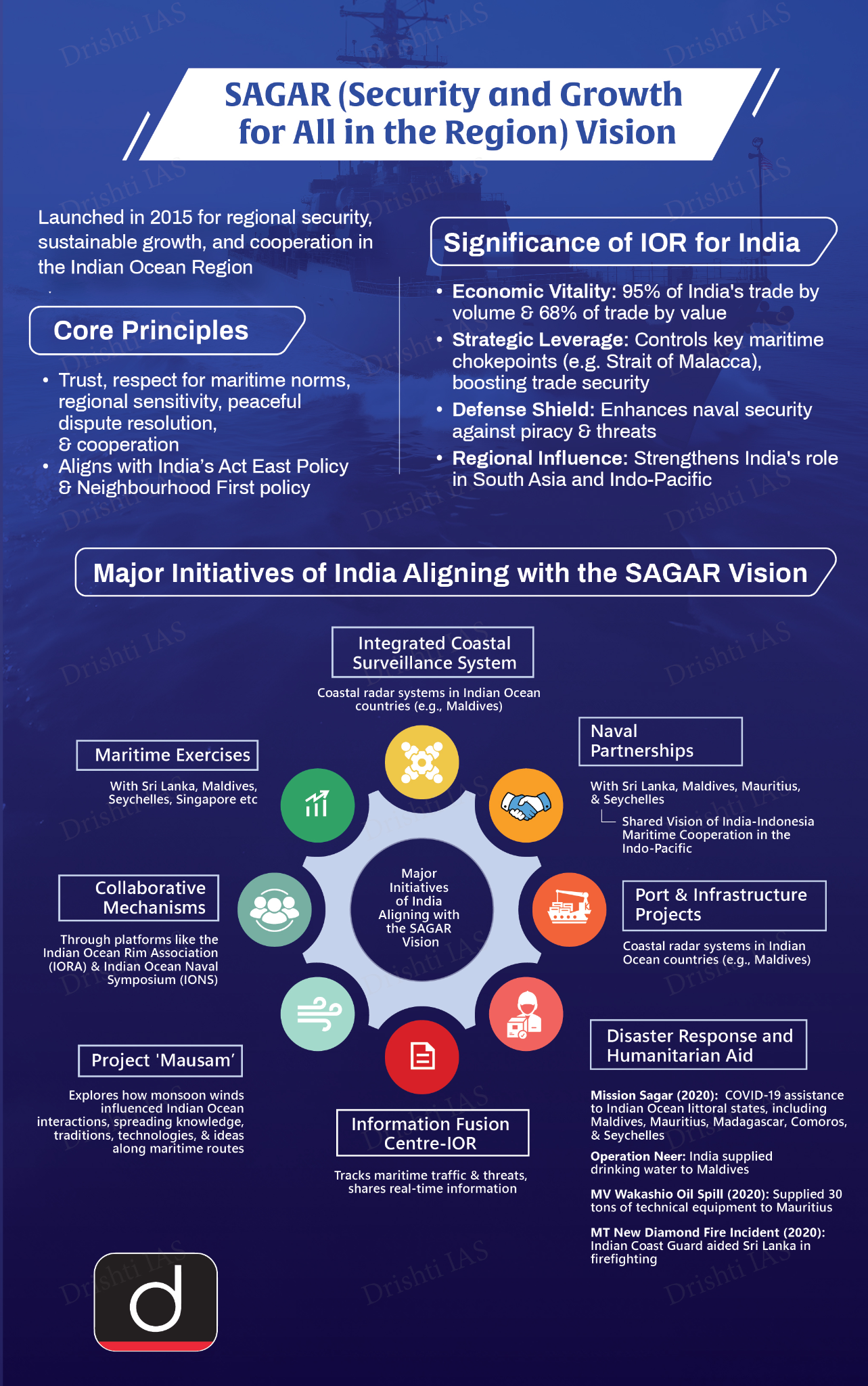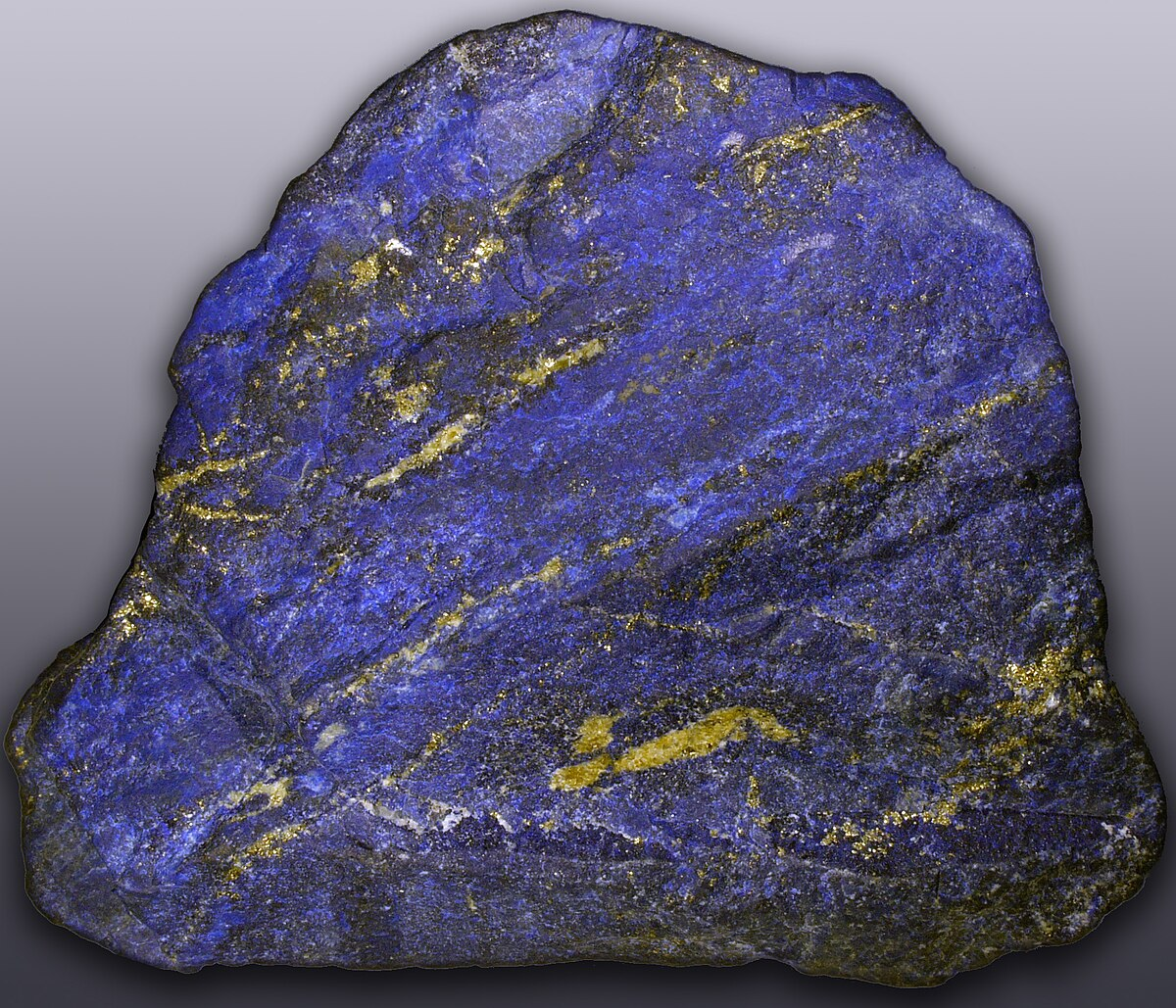Indian Polity
Judicial Transfers and In-House Inquiry
For Prelims: Collegium System, In-house inquiry procedure, Chief Justice of India
For Mains: Judicial Transfers in India, Comparison between In-House Inquiry and Impeachment Process, Judicial Ethics and Integrity
Why in News?
The Supreme Court (SC) Collegium has recommended the transfer of Delhi High Court Judge (Justice Yashwant Varma) to the Allahabad High Court. This decision comes in the wake of allegations regarding the discovery of “sacks of burnt currency” at his residence.
- Simultaneously, an in-house inquiry procedure was initiated by Chief Justice of India (CJI) Sanjiv Khanna to conduct a deeper investigation into the incident.
- The move upholds the Restatement of Values of Judicial Life, ensuring judicial integrity, and accountability.
What is the Process of Judicial Transfers in India?
- Constitutional Provision: Article 222 of Indian Constitution empowers the President, based on the recommendation of the CJI, to transfer a judge (including Chief Justice) from one High Court to another.
- Consent of the judge is not required, whether it is the first or a subsequent transfer.
- Role of the CJI and the Collegium: The CJI initiates the transfer proposal and his opinion is determinative.
- For transferring a Judge (not Chief Justice), the CJI consults the Chief Justice of the transferring High Court and the receiving High Court and considers input from one or more SC judges who know the concerned judge’s performance.
- For transferring a Chief Justice, the proposal is reviewed by the CJI along with the four senior-most judges of the Supreme Court, collectively forming the Collegium.
- In making the final decision, the Collegium also considers personal aspects of the judge, like health conditions, and location preferences.
- Role of the Executive: The Union Law Minister forwards the Collegium’s recommendation to the Prime Minister, who advises the President to approve the transfer.
- Upon approval, the Department of Justice notifies the transfer in the Gazette of India, and the Chief Justices and Chief Ministers of the concerned states are informed.
- Importance of Transfers: Help in optimizing judicial efficiency across High Courts by balancing workload and expertise.
- Prevents undue influence or bias that may arise from prolonged tenure and helps to preserve public trust by addressing concerns about impartiality and judicial misconduct.
What is an In-House Inquiry?
- In-House Inquiry: The Supreme Court introduced an in-house inquiry procedure in 1999. This was prompted by the C. Ravichandran Iyer v. Justice A.M. Bhattacharjee case (1995), which exposed the absence of a mechanism to deal with judicial misconduct falling below the impeachment (Article 124 and 218 of the Constitution) threshold.
- A five-member committee proposed the in-house Inquiry framework in 1997, which was formally adopted in 1999.
- The procedure was reaffirmed and detailed in Additional District and Sessions Judge 'X' vs Registrar General, Madhya Pradesh HC (2014), detailed out internal process for judicial inquiries.
- Procedure: The in-house inquiry process begins when a complaint against a judge is received by the CJI, a High Court Chief Justice, or the President, it need not originate from Parliament.
- If found credible, the CJI may ask the concerned High Court CJ to conduct a preliminary inquiry.
- Based on this report, if deeper investigation is needed, the CJI constitutes a three-member committee (two Chief Justices and one High Court judge).
- The committee conducts the inquiry while ensuring natural justice, allowing the judge to respond. The final report submitted to the CJI must state whether the allegations are substantiated and if they warrant removal.
- If the misconduct is minor, the judge may be warned or advised, and the report kept confidential ( but placed on record).
- If serious misconduct is established, the judge may be asked to resign or retire.
- Upon refusal, the judge may be relieved of judicial duties, and if necessary, the CJI may recommend impeachment.
What is Restatement of Values of Judicial Life?Click here to Read: Restatement of Values of Judicial Life |
In-House Inquiry Vs. Constitutional Impeachment
|
Aspect |
In-House Inquiry Mechanism |
Constitutional Impeachment |
|
Basis |
Based on Supreme Court resolutions (1999) |
Article 124(4) (removal of Supreme Court judge) & 218 of the Constitution (removal of High Court judges) |
|
Applicability |
Judicial misconduct below impeachment threshold |
Only for “proved misbehaviour or incapacity” |
|
Initiated by |
CJI, High Court Chief Justice, or President |
Members of Parliament |
|
Process Type |
Internal, confidential judicial mechanism |
Parliamentary and public process |
|
Outcome |
Advice, warning, or recommendation for resignation/retirement |
Removal from office by Presidential order |
|
Role of Parliament |
No involvement |
Requires 2/3rd majority in both Houses |
|
Transparency |
Confidential process to protect judicial dignity |
Public and media-visible process |
|
Final Authority |
Chief Justice of India |
President of India (on PM’s advice after Parliament vote) |
|
Drishti Mains Question: What is the in-house inquiry procedure for judges in India? How does it address judicial misconduct? |
UPSC Civil Services Examination, Previous Year Question (PYQ)
Prelims
Q. With reference to the Indian judiciary, consider the following statements: (2021)
- Any retired judge of the Supreme Court of India can be called back to sit and act as a Supreme Court judge by the Chief Justice of India with the prior permission of the President of India.
- A High Court in India has the power to review its own judgement as the Supreme Court does.
Which of the statements given above is/are correct?
(a) 1 only
(b) 2 only
(c) Both 1 and 2
(d) Neither I nor 2
Ans: (c)
Mains
Q.Critically examine the Supreme Court’s judgement on ‘National Judicial Appointments Commission Act, 2014’ with reference to appointment of judges of higher judiciary in India. (2017)


Social Issues
Migration Trends in India post-Covid-19
For Prelims: Migration, Smart Cities Mission, e-Shram Portal, Remittance, Donkey Route
For Mains: Migration trends in India post-COVID-19, Challenges in migration governance and policy implementation
Why in News?
Five years after the Covid-19 pandemic, migration patterns in India have seen significant shifts. While rural-to-urban migration has resumed, international emigration has diversified.
- Understanding these trends and improving migration governance is crucial to addressing the migrants challenges and maximizing the benefits of migration.
What are the Key Migration Trends in India post-Covid-19?
- Urban to Rural Migration: The Covid-19 crisis caused unprecedented urban-to-rural reverse migration, with 44.13 million moving from urban areas to rural regions during the first lockdown and 26.3 million in the second.
- Returning migrants, primarily low-skilled workers, faced wage theft, food insecurity, lack of healthcare, discrimination, economic strain, and unemployment as urban jobs disappeared.
- Rebound of Rural-to-Urban Migration: Rural economies failed to absorb the returning workforce, as inadequate employment (MGNREGA offered only partial relief), low wages, and urban aspirations pushed migrants back to cities.
- The Smart Cities Mission (aims to develop 100 cities into modern urban hubs and relies heavily on migrant labour) is encouraging urban migration.
- According to the Economic Survey 2023-24, it is expected that by 2030, more than 40% of India's population will reside in urban areas.
- Climate-Induced Migration: Climate change is influencing aspirational and distress migration, especially from agrarian states like Odisha (FAO-IIMAD report).
- International Migration Shifts: During Covid-19, Indian emigrants faced job losses, wage cuts, and poor healthcare access, yet remittances remained strong (USD 83.15 billion in 2020), accompanied by growing global demand for Indian healthcare workers
- Post-Covid, many Indian migrants shifted from the Gulf to advanced economies (AEs) for better opportunities.
- Indians are exploring Europe (via the EU Blue Card programme in 2023 for skilled professionals) and Africa for opportunities in IT, manufacturing.
- Canada’s Express Entry and Australia’s immigration policies attracted skilled Indian professionals, offering high-paying jobs and boosting remittances (USD 118.7 billion in 2023-24).
- Student migration surged post-pandemic, with Kerala’s student emigrants doubling from 1.29 lakh in 2018 to 2.5 lakh in 2023.
- Education-related remittances peaked at USD 3,171 million in 2021, reflecting a rise in international study trends.
- Post-Covid, many Indian migrants shifted from the Gulf to advanced economies (AEs) for better opportunities.
What are India's Challenges in Migration Governance?
- Inadequate Migration Data Systems: Delayed Census 2021 and outdated migration figures limit policy planning.
- The Periodic Labour Force Survey (PLFS) 2020-21 recorded a migration rate of 28.9%, a marginal increase from the 28.5% recorded in 2007-08.
- However, this data, collected during the Covid-19 migration flux, fails to reflect long-term trends.
- The Ministry of External Affairs (MEA) data tends to underestimate the number of emigrants, especially temporary and seasonal migrants. Additionally, illegal migration via 'donkey routes' remains unaccounted for in official records.
- Weak Implementation of Social Security Schemes: e-Shram Portal (2021) aimed to cover unorganized workers, suffers from low awareness and digital exclusion.
- One Nation One Ration Card (ONORC) aimed at food security for migrants but large sections remain uncovered.
- The weak implementation of the Inter-State Migrant Workmen Act, 1979, leaves many workers unregistered and unprotected due to inadequate monitoring and unlicensed contractors.
- The new Four Labour Codes introduced in 2020 aim to expand migrant worker protections but face delays in rule framing and enforcement.
- Limited Portability of Entitlements: Migrants often lose access to state-specific schemes when moving to other regions. Despite ONORC and Ayushman Bharat, inter-state policy harmonization remains weak.
- Neglect of Vulnerable Groups: Women and children are often overlooked in migration policies.
- Women face risks like trafficking and exploitation, while migrant children suffer from disrupted education, poor healthcare, which increases their chances of being marginalized and mistreated.
- Weak Protection for Low-Skilled Migrants: Gulf nationalization policies (Nitaqat, Emiratization) reduce job opportunities, while low-skilled migrants face poor working conditions and wage theft.
- There are gaps in providing adequate skilling and pre-departure orientation for emigrants, which affects their preparedness and safety abroad.
- Limited Role of Local Governance: Panchayats often lack the mandate, resources, and capacity to support migrant populations.
- Climate-Induced Migration Overlooked: Migration due to climate stress (e.g., floods, droughts, sea-level rise) is not recognized in disaster or climate adaptation policies.
- This leads to policy neglect for communities undergoing distress-induced mobility.
- Stigma and Discrimination: Migrants often face xenophobia, cultural alienation, and lack of social inclusion, especially in destination cities.
How can India Strengthen its Migration Governance?
- National Migration Data Models: Kerala Migration Surveys provide robust data, shaping better policies. States like Odisha, Tamil Nadu, Gujarat, and Punjab are replicating this model.
- A national-level adoption could standardize and enhance migration governance.
- National Migration Policy: Expedite NITI Aayog’s draft National Policy on Migrant Workers, which focuses on their overall development.
- Consider formulating a unified framework addressing both internal and international migration, ensuring inter-ministerial coordination (Labour, MEA, Urban Affairs) with rights-based and gender-sensitive provisions.
- Enhance International Migration Frameworks: Expand labour mobility agreements with emerging destinations in the European Union (EU), and Africa.
- The India Centre for Migration (research think-tank to MEA) can help to strengthen Pre-Departure Orientation Training (PDOT) and skill-building programs, aligning them with destination-specific demands.
- Improve Social Security Access and Portability: Implement the Code on Social Security, 2020 effectively to ensure coverage of all unorganised and migrant workers, including inter-state portability of benefits.
- Ensure portability of entitlements (ration, health insurance, pensions) across states via digital platforms.
- Establish one-stop migrant facilitation centres in urban clusters for enrolment, legal aid, and grievance redressal.
What is Migration?Click here to Read: Migration |
|
Drishti Mains Question: Discuss the major challenges in India's migration governance post-COVID-19 and suggest policy measures for improvement. |
UPSC Civil Services Examination, Previous Year Questions (PYQs)
Q. What are the main socio-economic implications arising out of the development of IT industries in major cities of India? (2021)
Q. Discuss the changes in the trends of labour migration within and outside India in the last four decades. (2015)Q. Discuss the changes in the trends of labour migration within and outside India in the last four decades. (2015)


International Relations
Route for IORA Under India’s Chairship
For Prelims: Indian Ocean Rim Association (IORA), Indian Ocean, terrorism, human trafficking, disaster risk management, maritime security, fisheries management,blue economy, Security and Growth for All in the Region (SAGAR) vision.
For Mains: India’s Role and Contributions in IORA, Role of IORA in Regional Cooperation.
Why in News?
As India gets ready to take over as Indian Ocean Rim Association (IORA) Chair in November 2025 (currently vice chair), it aims to make the organization’s governance more resilient.
- India plans to boost IORA’s budget, enhance data management with technology, and collaborate with institutions to develop maritime courses over the next two years.
What is the Indian Ocean Rim Association (IORA)?
- About: IORA is an intergovernmental organisation established to promote economic cooperation and regional integration among countries bordering the Indian Ocean.
- IORA member states work on various initiatives related to trade, investment, and sustainable development in the Indian Ocean region (IOR).
- Background: It was established on 7th March 1997. The vision for IORA originated during a visit by late President Nelson Mandela of South Africa to India in 1995.
- This idea led to the Indian Ocean Rim Initiative (IORI) in 1995 and the formation of the Indian Ocean Rim Association for Regional Cooperation (IOR-ARC) in 1997, now known as IORA.
- Membership: IORA welcomes all sovereign states along the Indian Ocean Rim that adhere to its Charter’s principles and objectives.
- Currently, it comprises 23 member states and 10 dialogue partners, IORA covers Asia, Africa, and Oceania, connecting nations via the Indian Ocean waters.
Indian Ocean Region
- The IOR forms a unique geopolitical and economic zone within the broader Indo-Pacific region.
- It is home to two-thirds of the world’s population and plays a crucial role in global trade and energy security.
- The Indian Ocean facilitates 75% of global trade and 50% of daily oil consumption, generating USD 1 trillion in goods and services, with intra-IORA trade reaching USD 800 billion in 2023.
What is India’s Role and Strategic Contributions in IORA?
- Alignment with SAGAR Vision: India’s Security and Growth for All in the Region (SAGAR) vision closely aligns with IORA’s strategic objectives, emphasizing maritime security, economic cooperation, and sustainable development.
- Leveraging Diplomatic and Economic Ties: India should capitalize on its strong diplomatic and economic relations with IORA member states to foster long-term, sustainable, and cooperative solutions for regional challenges.
- Enhancing IORA’s Budget: India plans to secure sustainable IORA funding through public-private partnerships, leveraging maritime sectors like shipping, oil, gas, and tourism to boost economic cooperation.
- Integrating Technology: India aims to enhance data governance and policy analysis through digital tools, ensuring transparency, efficiency, and faster decision-making.
- Maritime Capacity Building: India will partner with academic institutions to introduce marine-focused courses, building a skilled workforce to drive innovation and growth in the blue economy.
What is the Role of IORA in the Indian Ocean Region?
- Role in Regional Cooperation: The IORA, recognized as one of the longest-standing regional inter-governmental organizations, plays a pivotal role in fostering multifaceted cooperation among its member states.
- Facilitation of Dialogue: IORA actively facilitates structured dialogue on cultural and academic exchanges, disaster risk management, and maritime security, aiming to strengthen regional resilience and promote sustainable development.
- Influence of Middle and Small Powers: While global powers like the U.S., China, and the EU engage as dialogue partners, IORA is mainly driven by middle and small powers that shape its agenda and decisions.
What are the Challenges Faced by IORA?
- Financial Constraints: IORA faces significant financial constraints (USD 1.3 billion budget for 2020-2025), as its annual budget remains heavily dependent on member-state contributions, which limits its ability to expand operations and implement large-scale initiatives.
- Most IORA members, except Singapore, the UAE, and France, are budget-constrained developing economies, weakening the organization’s financial stability.
- Resource-Intensive Engagement Areas: IORA’s expanding mandate in critical areas such as maritime safety, fisheries management, disaster risk reduction, blue economy, demands sustained financial and institutional resources, posing a challenge to its effective implementation and long-term impact.
- Private Sector Involvement: IORA struggles to attract private sector engagement from key maritime industries like shipping, oil & gas, and tourism.
- Without stronger partnerships, it risks missing out on alternative funding sources, improved operational efficiency, and long-term financial sustainability.
- Limited Institutional Capacity: IORA’s Secretariat in Mauritius operates with a small workforce and constrained resources, which limits its ability to effectively manage administrative and strategic functions.
- Challenges in Data Management: The lack of advanced data management systems results in inefficient record-keeping, increasing the margin of error and hindering accurate policy formulation and decision-making.
Conclusion
Building a skilled maritime workforce requires industry-academia collaboration and specialized courses in key areas. Strengthening partnerships can drive innovation, address challenges, and ensure economic sustainability. As India leads IORA, enhancing regional cooperation and resource mobilization will maximize its impact.
|
Drishti Mains Question: Examine India's strategic role in IORA. How can India leverage investments and traditional knowledge for sustainable regional governance? |
UPSC Civil Services Examination, Previous Year Question (PYQ)
Q. With reference to ‘Indian Ocean Rim Association for Regional Cooperation (IOR-ARC), consider the following statements: (2015)
- It was established very recently in response to incidents of piracy and accidents of oil spills.
- It is an alliance meant for maritime security only.
Which of the statements given above is/ are correct?
(a) 1 only
(b) 2 only
(c) Both 1 and 2
(d) Neither 1 nor 2
Ans: (d)


Rapid Fire
World Water Day 2025
The Ministry of Jal Shakti has launched the 6th edition Jal Shakti Abhiyan: Catch the Rain campaign 2025 on 22nd March 2025 (World Water Day) with the theme: “People’s Action for Water Conservation- Towards Intensified Community Connect” (Jal Sanchay Jan Bhagidari: Jan Jagrukta Ki Or).
- The government reaffirmed its commitment to the principle of “Every Drop Counts” with the focus on 148 districts across India for water conservation, rainwater harvesting, and groundwater recharge.
- The "Jal-Jangal-Jan" Abhiyan was launched with the focus on restoring ecological links between forests, rivers, and springs.
World Water Day:
- About: It aims to raise awareness about water conservation and its sustainable management.
- It was conceptualized at the 1992 Rio Summit and officially designated to be observed annually by the United Nations General Assembly (UNGA) in 1993.
- Aligns with SDG: The day aligns with UN SDG-6: Ensuring water and sanitation for all by 2030.
- Theme (2025): ‘Glacier Preservation’
Government Scheme for Water Conservation: Jal Shakti Abhiyan (JSA), AMRUT 2.0, Atal Bhujal Yojana.
| Read More: Making Water Management Effective in India. |


Important Facts For Prelims
Targeted Species-Specific Conservation
Why in News?
A global study published in PLOS Biology has found that targeted conservation efforts have helped prevent the extinction of numerous animal species, highlighting the effectiveness of species-specific interventions for conservation.
How Have Targeted Conservation Efforts Impacted Global Biodiversity?
- Direct Impact: Nearly 99.3% of species that improved in the IUCN Red List category since 1980, benefitted from conservation measures. Out of 969 species with increasing populations, 78.3% had active conservation interventions in place.
- Species-Specific Outcomes:
- Iberian Lynx: Grew from a few hundred to several thousand individuals through breeding and habitat management.
- Kākāpō: A New Zealand parrot revived through intensive monitoring and predator control.
- European Bison: Reintroduced into wild areas in Eastern Europe after complete extinction in the wild in the early 20th century.
What is India's Species-Specific Conservation Programme?
- The Integrated Development of Wildlife Habitats (IDWH-2008) approved for continuation during the 15th Finance Commission cycle (2021–26), aims to strengthen wildlife conservation of critically endangered species in India through captive breeding, and habitat restoration with community participation.
- Under the Species Recovery Programme, 22 species (16 terrestrial and 6 aquatic) have been prioritised for focused conservation.
- It includes subcomponents like Project Tiger (1973), Project Elephant (1992), Development of Wildlife Habitat (covering Project Dolphin, Project Lion, and Project Cheetah).
- Project Crocodile, was initiated by the United Nations and the Government of India, (following the enactment of the Wild Life (Protection) Act, 1972) to boost crocodile populations through captive breeding and to protect their natural habitats.
- The saltwater crocodile population in Bhitarkanika has significantly increased from 95 individuals in 1975 to 1,811.
- Sea Turtle Conservation Project (1999) for Olive Ridley & other sea turtles, especially in Odisha.
- Olive Ridley Turtle listed as vulnerable (IUCN); WLPA Schedule I & CITES Appendix I.
- MoEFCC launched a Vulture Action Plan 2020-25 for the conservation of vultures in the country. It will ensure minimum use of Diclofenac and prevent the poisoning of the principal food of vultures, the cattle carcasses.
- A Vulture Care Centre (VCC) was established in Pinjore, Haryana in 2001 to study vulture deaths in India.
- In 2004, it was upgraded to India’s first Vulture Conservation and Breeding Centre (VCBC) to support captive breeding and conservation efforts.
- Indian Rhino Vision 2020 launched in 2005 to increase the population of Greater One-Horned Rhinoceros in Assam. The Rhino population at Kaziranga National Park is now over 2,600 (as of 2022).
- The Maharashtra forest department is set to be the first state in India to have a dedicated action plan for conservation of pangolins.
- Pangolins are listed in Schedule I of India’s Wildlife (Protection) Act, 1972, implying the highest degree of protection.
- Project Cheetah (2022) aims to reintroduce Cheetahs, extinct in India since 1952. Cheetahs from Namibia and South Africa were brought to Kuno National Park.
- First cheetah birth in the wild in India after 75 years occurred in 2023.
UPSC Civil Services Examination Previous Year Question (PYQ)
Q. Vultures which used to be very common in Indian countryside some years ago are rarely seen nowadays. This is attributed to (2012)
(a) the destruction of their nesting sites by new invasive species
(b) a drug used by cattle owners for treating their diseased cattle
(c) scarcity of food available to them
(d) a widespread, persistent and fatal disease among them.
Ans: (b)


Rapid Fire
Lapis lazuli
Lapis lazuli, a metamorphic rock and semi-precious gemstone known for its deep blue color, symbolizes wealth, power, and status across ancient civilizations.
- Etymology: The name originates from Latin ("lapis" = stone) and Persian ("lazuli" = blue).
- Composition: The intense blue color comes from lazurite (25-40%), influenced by sulphur content. Presence of calcite reduces blueness, while pyrites add a golden shimmer.
- Major Sources: Though found in multiple countries like Chile, Russia, and the US, but the finest lapis lazuli comes from Afghanistan’s Badakhshan province, where it has been mined for over 6,000 years.
- Significance in India: Traders in India imported lapis lazuli from Badakhshan as early as 1000 BC, with ornamental pieces found in Indus Valley sites like Mohenjo-daro and Harappa.
- Global Usage: Ancient Egyptians used it for jewelry and cosmetics, while Renaissance artists ground it into ultramarine pigment for paintings.
| Read more: Menhirs |


Rapid Fire
WEF UpLink Annual Impact Report 2025
The World Economic Forum’s (WEF) UpLink Annual Impact Report 2025 highlights the contributions of start-ups supported through WEF’s UpLink platform in driving innovation for climate action.
- Key Findings: In 2023-2024 UpLink-supported ventures have prevented 142,400 tonnes of carbon emissions.
- 140 million hectares of land and water ecosystems protected (nearly one-fifth the size of the Amazon rainforest).
- Additionally, they have treated 2.5 billion litres of hazardous wastewater, reducing environmental pollution, and tracked 28 million tonnes of waste, enhancing waste management efficiency.
- 2.7 million people gained access to improved water, sanitation, and hygiene solutions.
- Indian start-up Indra Water processed 1.2 billion litres of wastewater in 2024, a 243% increase from 2022.
- S4S (Science For Society) reduced 60,000 tonnes of food waste, enough to feed 2.7 million people for a month.
- UpLink platform: Launched by the WEF at Davos in 2020 in collaboration with Deloitte and Salesforce, UpLink is an open innovation platform that connects entrepreneurs and experts to drive the UN Sustainable Development Goals (SDGs) and scale impactful solutions.
| Read more: World Economic Forum Annual Meeting 2025 |


Rapid Fire
New Insights into Human Evolution
A recent study challenges the long-held belief that modern humans (Homo sapiens) evolved from a single ancestral population, suggesting instead that they emerged through the admixture of two distinct populations.
- The research analyzed modern human DNA to trace population splits and reunions, relying on data from the 1000 Genomes Project rather than ancient fossils.
- The 1000 Genomes Project is a global initiative that sequenced DNA from populations across Africa, Asia, Europe, and the Americas.
Key Findings:
- Multiple Ancestry & Evolution: Modern humans (Homo sapiens) likely evolved from 2 ancestral populations, with one majority (~80%) experiencing a significant decline before recovering, while the other minority (~20%) contributed genes linked to brain function and cognition.
- Some genes from the minority group underwent purifying selection, indicating evolutionary pressures that shaped human development.
- This genetic exchange contributed nearly 10 times more material than the later Neanderthal-Denisovan interbreeding (~50,000 years ago), which accounts for only ~2% of non-African human DNA.
- Genetic Mixing: These populations diverged around 1.5 million years ago and later interbred approximately 300,000 years ago, forming the genetic foundation of modern humans.
| Read More: Genome India Project, Human Evolution and Migration. |











